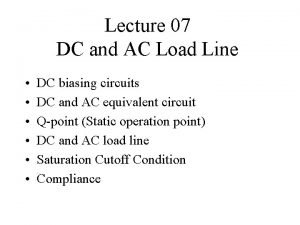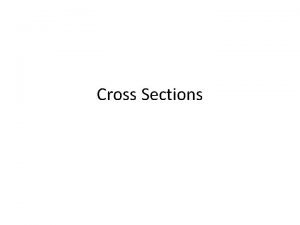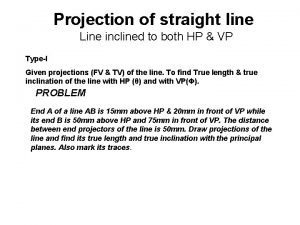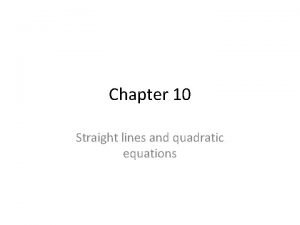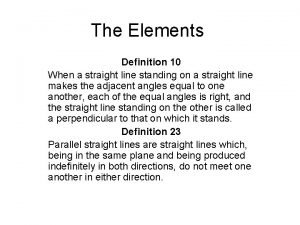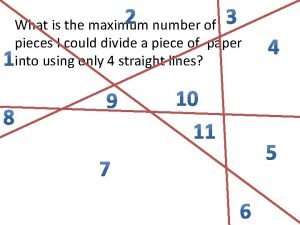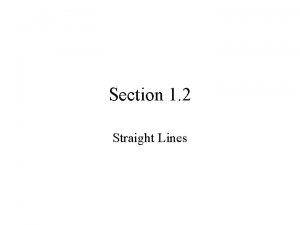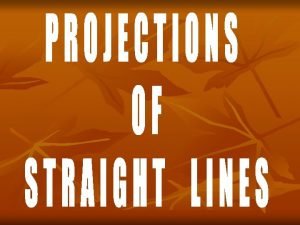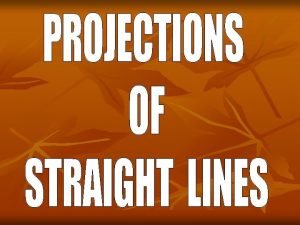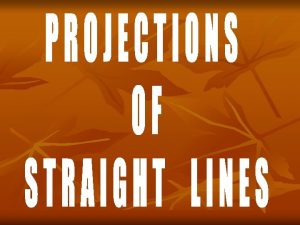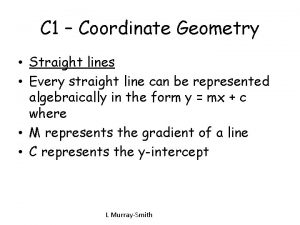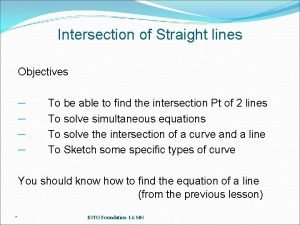Section 1 4 Intersection of Straight Lines Intersection









- Slides: 9

Section 1. 4 Intersection of Straight Lines

Intersection Point of Two Lines Given the two lines m 1 , m 2, b 1, and b 2 are constants Find a point (x, y) that satisfies both equations. L 1 L 2 Solve the system consisting of

Ex. Find the intersection point of the following pairs of lines: Notice both are in Slope-Intercept Form Substitute in for y Solve for x Find y Intersection point: (4, 9)

Break-Even Analysis The break-even level of operation is the level of production that results in no profit and no loss. Profit = Revenue – Cost = 0 Revenue = Cost break-even point Dollars loss Revenue profit Cost Units

Ex. A shirt producer has a fixed monthly cost of $3600. If each shirt has a cost of $3 and sells for $12 find the break-even point. If x is the number of shirts produced and sold Cost: C(x) = 3 x + 3600 Revenue: R(x) = 12 x At 400 units the break-even revenue is $4800

Market Equilibrium occurs when the quantity produced is equal to the quantity demanded. price supply curve demand curve x units Equilibrium Point

Ex. The maker of a plastic container has determined that the demand for its product is 400 units if the unit price is $3 and 900 units if the unit price is $2. 50. The manufacturer will not supply any containers for less than $1 but for each $0. 30 increase in unit price above the $1, the manufacturer will market an additional 200 units. Both the supply and demand functions are linear. Let p be the price in dollars, x be in units of 100 and find: a. The demand function b. The supply function c. The equilibrium price and quantity

a. The demand function b. The supply function

c. The equilibrium price and quantity Solve simultaneously. and The equilibrium quantity is 960 units at a price of $2. 44 per unit.
 Ac load line
Ac load line How to describe a cross section
How to describe a cross section Light travels in straight lines
Light travels in straight lines A line ab 75mm long is inclined at 45 to hp and 30 to vp
A line ab 75mm long is inclined at 45 to hp and 30 to vp Straight lines and quadratic equations
Straight lines and quadratic equations Definition 23 of parallel straight lines
Definition 23 of parallel straight lines Kinds of straight line
Kinds of straight line Connect 9 dots with 4 straight lines
Connect 9 dots with 4 straight lines Structural lines in fashion
Structural lines in fashion Patterns are made using straight lines and arcs
Patterns are made using straight lines and arcs
